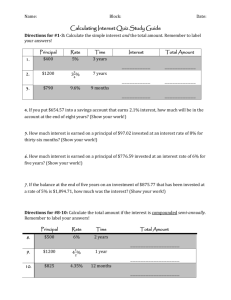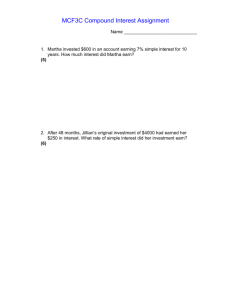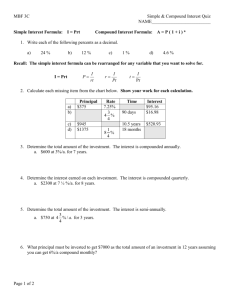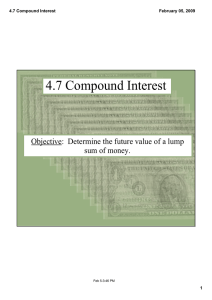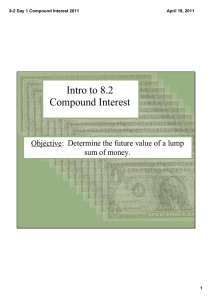Intro to 8.2 Compound Interest Objective: Determine the future value of a lump sum of money.
advertisement
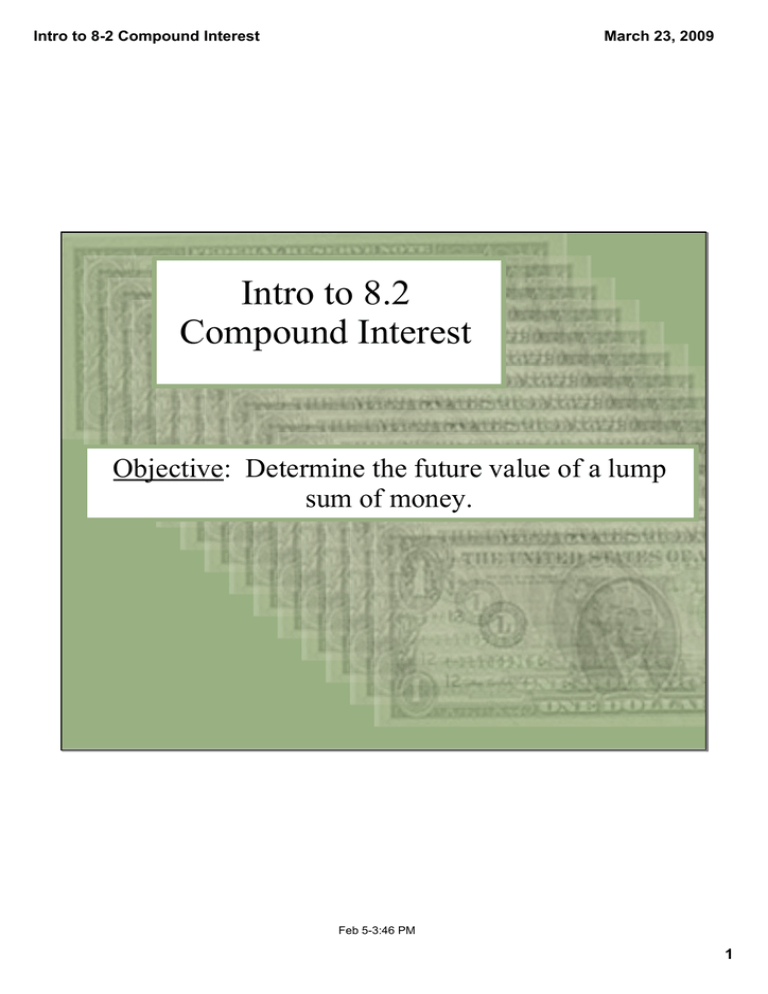
Intro to 8­2 Compound Interest March 23, 2009 Intro to 8.2 Compound Interest Objective: Determine the future value of a lump sum of money. Feb 5­3:46 PM 1 Intro to 8­2 Compound Interest March 23, 2009 Simple Interest Formula: In te t s e r I = Prt in Pr al p i c ars e y in e tim te a ts r e er t n i Feb 5­3:46 PM 2 Intro to 8­2 Compound Interest March 23, 2009 A credit union pays interest of 8% interest compounded quarterly on a savings account. If $1,000 is deposited and the interest is left to accumulate, how much is in the account after 1 year? I = Prt 1 I = ($1000)(0.08)( ) 4 I = $20 Feb 5­3:46 PM 3 Intro to 8­2 Compound Interest March 23, 2009 Therefore, at the end of one quarter we have earned $20 in interest. My principal is now $1020. So at the end of the second quarter, how much do I earn? 1 I = ($1020)(0.08)( ) 4 I = $20.40 Adding that interest to the money in my account, I now have $1040.40 six months into the year. Feb 5­3:46 PM 4 Intro to 8­2 Compound Interest March 23, 2009 At the end of the third quarter, how much do I have? 1 I = ($1040.40)(0.08)( ) 4 I = $20.81 This brings my principal to $1,061.21. Feb 5­3:46 PM 5 Intro to 8­2 Compound Interest March 23, 2009 At the end of the fourth quarter, or at the end of the year what do I have? 1 I = ($1061.21)(0.08)( ) 4 I = $21.22 This brings the total in my bank account to $1,082.43 just by collecting interest. Feb 5­3:46 PM 6 Intro to 8­2 Compound Interest March 23, 2009 This process can be very lengthy especially if the interest were being compounded daily. This leads to a more general formula for calculating interest that is compounded. Compounded interest formula: r nt A = P(1 + ) n n = the number of compounds per year Feb 5­3:46 PM 7 Intro to 8­2 Compound Interest March 23, 2009 Compounded interest is interest that is paid on principal and previously earned interest. Common forms of compounding are: annually: once per year semiannually: twice per year quarterly: four times per year monthly: 12 times per year daily: 365 times per year Feb 5­3:46 PM 8 Intro to 8­2 Compound Interest March 23, 2009 Lets compare investments using different compounding periods. nt r A = P(1 + ) n n = the number of compounds per year Find the resulting amount of an investment of $3000 when it is compounded annually, semiannually, quarterly, monthly and daily at a rate of 4% for a period of 3 years. (1 3) 0.04 A = (3000)(1 + ) 1 3 A = (3000)(1 + 0.04) 3 A = (3000)(1.04) A = $3,374.59 Feb 5­3:46 PM 9 Intro to 8­2 Compound Interest March 23, 2009 Lets compare investments using different compounding periods. nt r A = P(1 + ) n n = the number of compounds per year Find the resulting amount of an investment of $3000 when it is compounded annually, semiannually, quarterly, monthly and daily at a rate of 4% for a period of 3 years. 0.04 (2 3) A = (3000)(1 + ) 2 A = (3000)(1 + 0.02) 6 6 A = (3000)(1.02) A = $3,378.49 Feb 5­3:46 PM 10 Intro to 8­2 Compound Interest March 23, 2009 Lets compare investments using different compounding periods. nt r A = P(1 + ) n n = the number of compounds per year Find the resulting amount of an investment of $3000 when it is compounded annually, semiannually, quarterly, monthly and daily at a rate of 4% for a period of 3 years. 0.04 (4 3) A = (3000)(1 + ) 4 12 A = (3000)(1 + 0.01) 12 A = (3000)(1.01) A = $3,380.48 Feb 5­3:46 PM 11 Intro to 8­2 Compound Interest March 23, 2009 Lets compare investments using different compounding periods. nt r A = P(1 + ) n n = the number of compounds per year Find the resulting amount of an investment of $3000 when it is compounded annually, semiannually, quarterly, monthly and daily at a rate of 4% for a period of 3 years. 0.04 (12 3) A = (3000)(1 + ) 12 A = (3000)(1 + 0.0033333333)36 A = (3000)(1.0033333333)36 A = $3,381.82 Feb 5­3:46 PM 12 Intro to 8­2 Compound Interest March 23, 2009 Lets compare investments using different compounding periods. nt r A = P(1 + ) n n = the number of compounds per year Find the resulting amount of an investment of $3000 when it is compounded annually, semiannually, quarterly, monthly and daily at a rate of 4% for a period of 3 years. 0.04 (365 3) A = (3000)(1 + ) 365 A = (3000)(1 + 0.0001095890411)1095 1095 A = (3000)(1.0001095890411) A = $3,382.47 Feb 5­3:46 PM 13 Intro to 8­2 Compound Interest March 23, 2009 How much principal is needed now to have $4000 after 2 years at 6% compounded quarterly? nt r A = P(1 + ) n n = the number of compounds per year 0.06 (4 2) 4000 = P(1 + ) 4 4000 = P(1 + 0.015) 8 4000 = P(1.015)8 4000 = P(1.126492587) P = $3,550.84 Feb 5­3:46 PM 14 Intro to 8­2 Compound Interest March 23, 2009 Homework 8.2 Interest Rates 1 /2 sheet Feb 5­3:46 PM 15 Intro to 8­2 Compound Interest March 23, 2009 What if the investment is compounded more often than daily? Compounding Interest Continuously: rt A = Pe Find the resulting amount of an investment of $3000 when it is compounded continuously at a rate of 4% for a period of 3 years. A = Pe rt A = (3000)e A = (3000)e (0.04 3) 0.12 A = $3,382.49 Feb 5­3:46 PM 16
